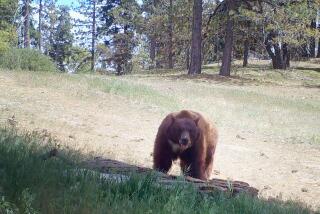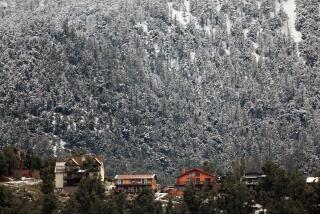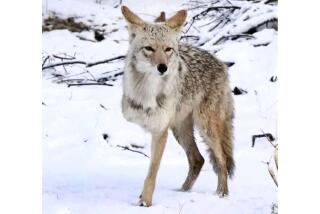A bear, a fawn and a lesson in nature at Yosemite
With bears devouring Costco meatballs, slumbering in backyard trees and generally dominating the local news of late, I’d like to share my own bear story. But mine takes place in Yosemite, and it is not recommended for children under the age of 7, even if that costs me half my readership.
My wife, daughter and I were vacationing earlier this month when, one day, we walked from our hotel to Curry Village to rent bikes. At the end of a path near a wooded area we saw people crouching with cameras.
A family of deer?
No.
A black bear.
It wasn’t black, but reddish and brown and about the size of a nice, comfy love seat. The bear lumbered along, not particularly interested in its fan club. I have to admit, I found it pretty exciting to see a wild animal foraging in its natural environment rather than looking for a discount meatball.
On the way back, pedaling through the same area, my wife stopped abruptly. She had seen a white-spotted fawn so young it was hardly bigger than a fox. We all got off our bikes to watch the fawn leap through the brush toward what looked like a fallen tree about 40 yards away.
It wasn’t a tree.
“All of a sudden the bear stood up, with its arms up,” recalls my wife, who had the best view. “It stood up in attack mode.”
Was the bear going after the fawn, which we’d lost sight of? Or was it about to come after us?
We couldn’t tell, nor were we inclined to hang around and find out. Particularly after I heard a death squeal that might have been the last breath of the fawn.
The park managers’ advice to visitors who spot a bear is to stay back at least 50 yards. But in a close encounter, people should “stand their ground and scare the bear away by raising their arms and making loud noises.” What they shouldn’t do is flee. I knew this, but apparently my mouth didn’t.
“Run!” I yelled, heart pounding in my ears as our 8-year-old ran alongside her bike, struggling to climb aboard.
As we pedaled away, a beautiful doe — presumably the fawn’s mother — came thundering past us at a full gallop. For all we knew, the bear was giving chase, but none of us looked back. We sped back to the lodge, and because you’re encouraged to report bear sightings, we told our story to the hotel manager.
She listened politely, but clearly, she considered us hopeless city slickers. And I can guarantee you, she hadn’t been following the story of the Glendale bear’s meatball hunt. In a condescending tone, she insisted that bears are vegetarians, so they wouldn’t be attacking other wildlife, and she was unaware of there ever being a bear attack on a human in Yosemite.
As it turns out, Miss Know-It-All was half-right.
An hour or two later, we saw a Yosemite ranger in the area where we had spotted the bear. She was standing still as a fence post, eyes fixed on something in the brush. It was the same bear, and when the ranger came toward us, we gave her our story.
“The bear is eating the fawn right now,” said the ranger. She said bears are primarily plant eaters, but they go after roadkill and don’t mind taking a fawn this time of year, when deer give birth.
The ranger said the bear probably had no intention of coming after us. She suspected the bear might have “bluff-charged” us to protect its fresh kill. Bears have been known to bluff-charge to within a few feet of humans, she said, especially to protect their cubs, but that’s rare. The ranger also guessed the doe’s flight was a futile diversionary tactic aimed at trying to draw the bear away from the fawn.
The policy among Yosemite’s rangers is to let bears like ours do their thing in natural habitats, said Kari Cobb, a ranger who serves as spokesperson. But bears are steered clear of campgrounds and busy public spaces to keep them from getting unnaturally comfortable with humans and hooked on people food. That’s why people are told to clear out anything edible from their cars, and to lock up food and trash. Cobb recommended the same for anyone living in L.A. suburbs frequented by bears.
“They’re not just eating the Snickers bar, they’re eating the wrapper it came in, and as you can imagine that’s not very good for the bear’s digestive system.”
Cobb said she has seen ketchup and mayonnaise packets in bear scat, along with utensils and a variety of other things. And as they become more human-like in their eating habits, their calorie count goes up.
“You can literally look at a bear and tell if it’s eating human food. Its fur doesn’t look glistening and shiny anymore, its weight is distributed to different parts of the body, they act differently and don’t look as healthy.”
When we met with the ranger in the woods after the fawn was killed, she was carrying a contraption that looked like an old indoor TV antenna. She said it picks up signals from tags clipped on bears’ ears so the staff can monitor their movements and be on the alert when they enter campgrounds and other public areas.
Our bear was known as Blue 53, one of a couple dozen bears whose names were on a card the ranger carried in her shirt pocket. Blue 53 is a 6-year-old, 222-pound male who moves around the park rather than sticking to any one area.
Should you come into contact, try to be braver than I was, give him some space, remember you’re on his turf. And be grateful for the encounter.
More to Read
Start your day right
Sign up for Essential California for news, features and recommendations from the L.A. Times and beyond in your inbox six days a week.
You may occasionally receive promotional content from the Los Angeles Times.







